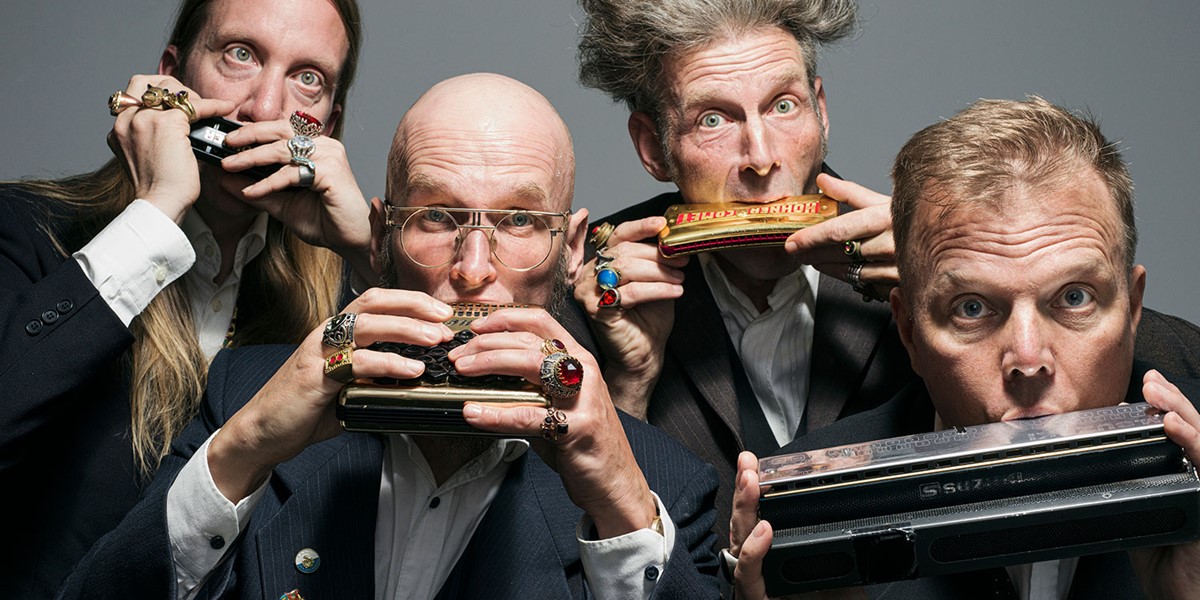Thursday, May 9, 2024
Sväng: A Beginner's Guide
Fiona Talkington unpacks the harmonica quartet’s trajectory, from the mind of Finland’s first mouth-harp graduate to an internationally acclaimed troupe with a repertoire ranging from Radiohead and Harry Potter to tango and Chopin

Sväng (photo: Kimmo Syväri)
I’m sitting in a field at a festival. Climbing over a wooden fence nearby are four men wearing very smart suits. I think that was our first encounter, though there were many more to come: stone churches on Orkney, downtown Helsinki, London’s Royal Opera House, and Jools Holland’s New Year’s Eve Hootenanny. Meet Sväng, Finland’s extraordinary harmonica quartet who conjure up magic, melancholy and mischief across a range of instruments, from the tiny harmonica pulled out of a top pocket, to the earthy bass version that’s the size of a toaster. It’s hard not to fall under the spell of their quirky brilliance.
Their recent release, Svängo Nuevo (2024), continues to surprise – I learnt that dancing Finnish tango is like cross-country skiing, for example – and ever-present is their trademark creative curiosity and deep sense of humanity. They are the harmonica equivalent of the legendary Kronos Quartet.
It began in Helsinki in the early 2000s where Jouko Kyhälä – the Sibelius Academy’s first harmonica graduate and Sväng founder – was teaching. Then student Eero Turkka was preparing for exams when Kyhälä suggested he compose for a harmonica band.
“But, is there a Finnish harmonica tradition?” I ask. “Oh yes!” Kyhälä answers emphatically, explaining a solo tradition which now has UNESCO Cultural Heritage status. But another inspiration for this new band, he tells me, was the Romanian group, Trio Polifonic. “We needed two more players,” Kyhälä continues. Another student, Eero Grundström was an obvious choice, but finding a bass harmonica player wasn’t so easy. Kyhälä approached Kimmo Pohjonen. He was too busy turning the accordion world upside-down but suggested Pasi Leino, another harmonicist with whom he’d been playing. So now, with Turkka’s exams over, Sväng was born!
“We’re four different personalities,” says Kyhälä. As a teen, he was into rock, but hearing Finnish legend J Karjalainen changed things. Kyhälä studied at the Sibelius Academy with Pohjonen – a “mind-blowing” experience – and switched to harmonica as his main instrument. Turkka was stunned when he first heard Muddy Waters and Little Walter at age 13. Interested in Finnish folk, Grundström took up the harmonica at the Academy because, he says, it was a smaller companion than his harmonium. Leino’s bass harmonica was gathering dust after his previous quartet disbanded, so he was delighted by this new eye- (and ear-) opening experience. Now that Leino has retired, he’s been replaced by Tapani Varis, a well-known musician on the Finnish scene for decades and a one-time member of Värttinä. How could he refuse the chance to compose for the band, he says. After all, the bass harmonica is a very “cool instrument.”
In 2005 Sväng released their self-titled first album. It catapulted them onto the music scene with their unique sound and an irresistible wit and brilliance over impossible dance rhythms, Finnish folk, Balkan beats, tango, blues and compelling melodies.
By the time Jarruta (2008) came along, Sväng had a worldwide fanbase and were exploring their own compositions, often inspired by beguiling Balkan rhythms, and performing with an exquisite clarity of sound and texture. Their take on the dark Finnish tango is ever-present. There’s a taste, too, of the humanity that’s an important thread throughout their music. Grundström’s ‘Deadline’ emerges from the soul using new sounds and techniques, with notes bending and swaying with their breath, as haunting as an eastern call to prayer. But expect the unexpected too, such as pieces inspired by comic books or the sounds of fish breeding.
As Schladtzshe! (2010) arrived, Sväng’s schedules became even busier with touring. In their compositions there’s a sense of renewed confidence and risk-taking, continuing to turn off-the-wall ideas into irresistible music: a Finnish snake tune unites Swedish polska with Greek fiddle music, the Finnish traditional humppa dance gets a remake, and the same country’s blues tradition is entwined with old hymn tunes via Radiohead. “We’ve always fought limitations, thinking more about what music we’re interested in,” says Grundström.
In 2010 the French Festival La Folle Journée de Nantes invited Sväng to arrange piano music by Chopin for harmonica. The result was an earthiness and sweetness that brought out the pathos and the Polish dance influences in Chopin’s music. It gave Sväng the idea of turning to Finland’s national composer, Sibelius. The 150th anniversary of his birth in 2015 was the perfect opportunity to realise that dream and consider, as Kyhälä puts it, “how to arrange the iconic, well-known orchestral works for four harmonicas.” Sibelius’ music is in their DNA, and you can sense this in their performances. “It’s a special feeling,” Grundström comments. “I noticed that we could play more freely with time, doing all the ritardandos and accelerandos together.”
Also released was Karja-La (2014) – their homage to the Karelia region. It shows, Kyhälä tells me, that they had matured as composers, surprising even themselves with their variety. It’s one of his favourite albums, deeply rooted in Finnish culture: traditional runo songs, heartfelt outpourings of age-old love stories and cross-border conflicts.
Sväng were on a roll. Hauptbahnhof (2017) was a gift to their fans, with all the old favourites, from traditional tunes to tango and Balkan rhythms, and new discoveries such as Grundström’s arrangement of ‘Hedwig’s Theme’ (the theme from the Harry Potter films).
They returned to their favourite dance form in Sväng Plays Tango (2018). This deeply melancholic music is a Finnish icon, and Sväng added their own tangos to a national archive. In 2020 came one of their finest albums, In Trad We Trust, rooted in what they say is their spiritual home, Finnish folk, including the kantele, jouhikko and fiddle traditions given the zany Sväng treatment.
Over the years they’ve been involved in many collaborations but one of their biggest projects now is with an orchestra, Svängfonia, launched in 2022 with the Tapiola Sinfonietta, exploring wider timbres and textures. “We could never imagine what we would achieve with this group,” says Kyhälä. “Sväng is a combination of being composer and arranger, being part of a physical unit, breathing together as one.”
Keep on svänging!
This article originally appeared in the June 2024 issue of Songlines. Never miss an issue – subscribe today

